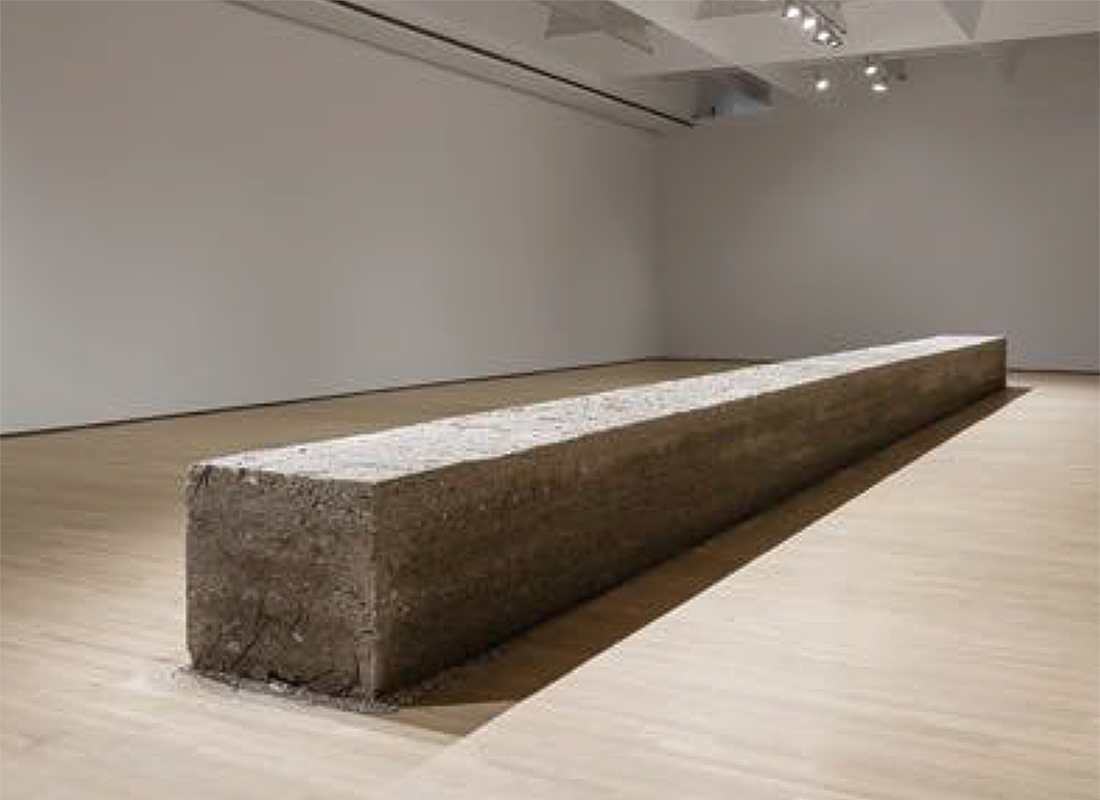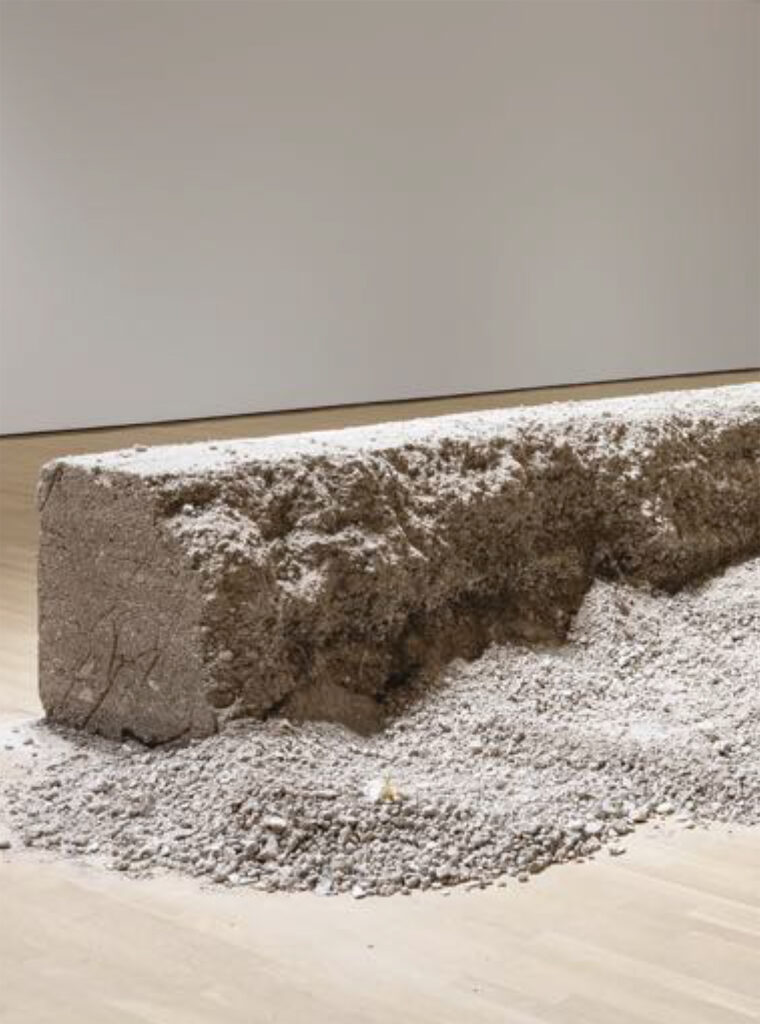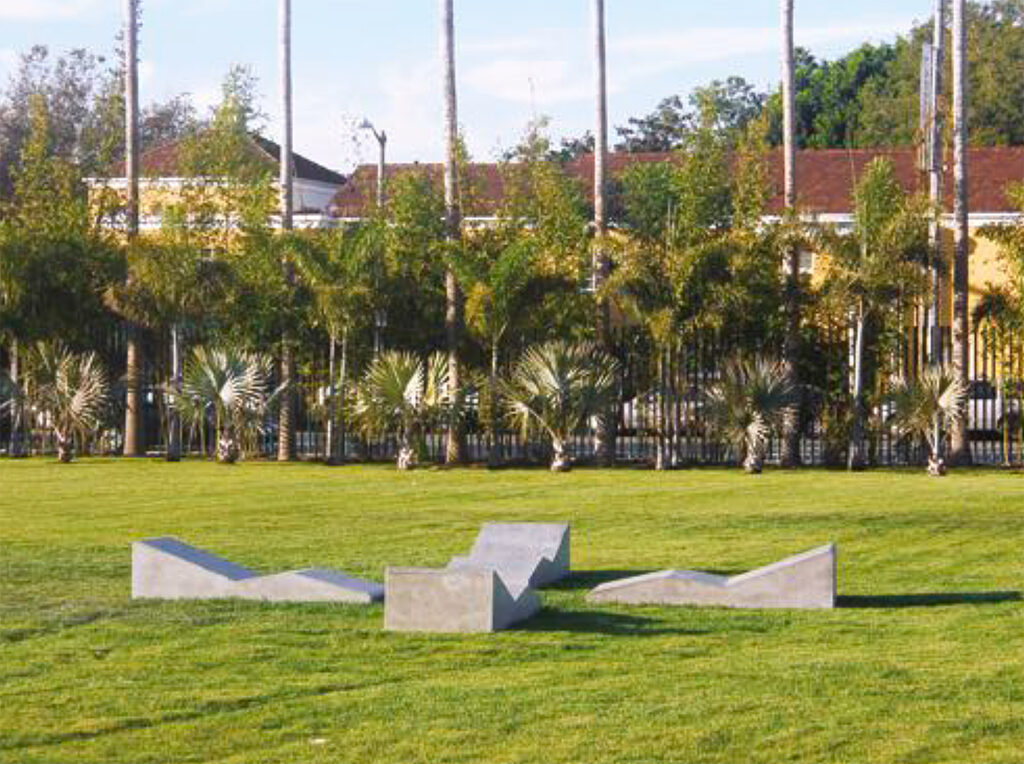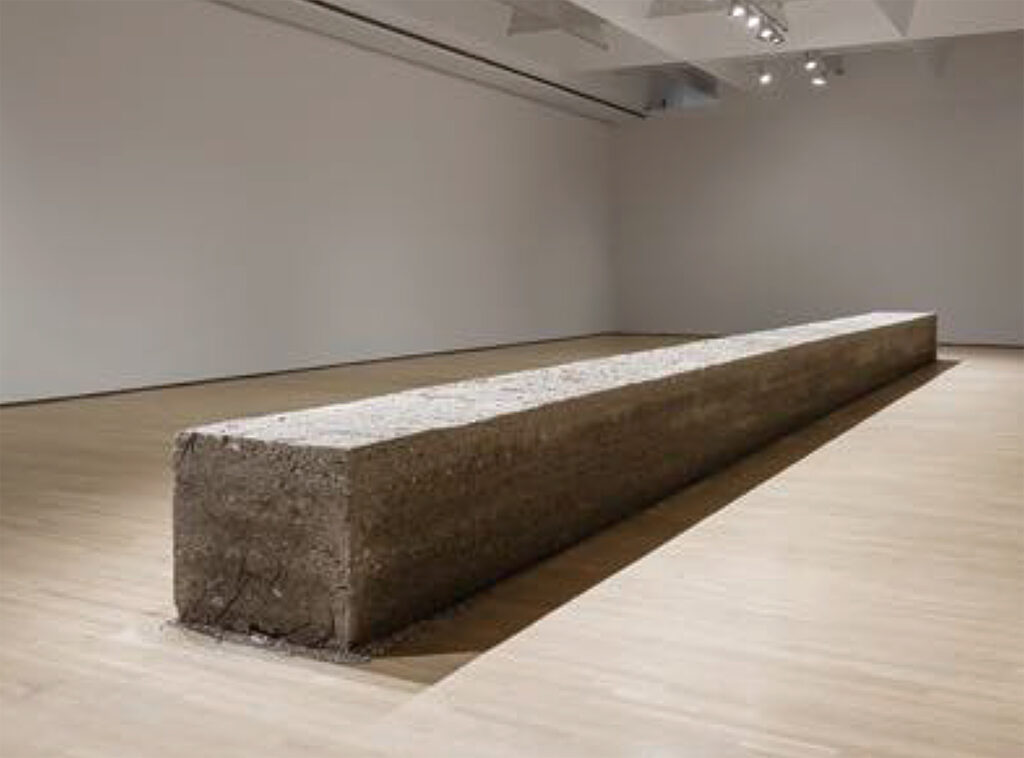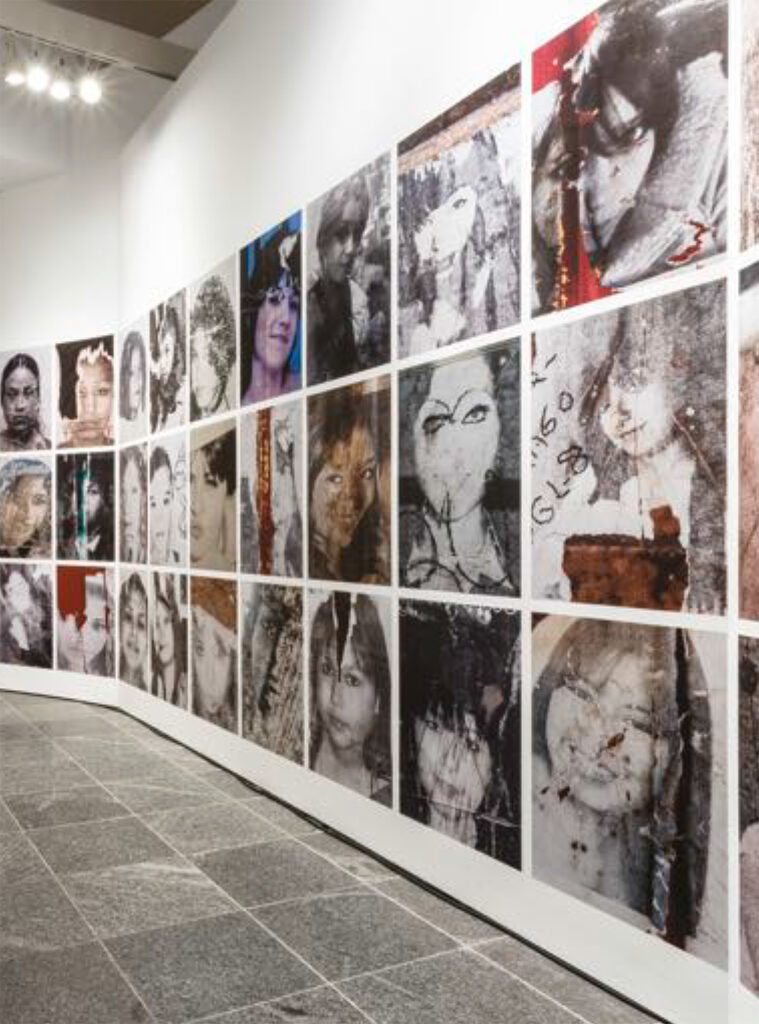Crisis and Circulation: The Representation of Flows in Teresa Margolles’ Recent Work
Illuminated signage tiles set on the floor of a museum’s exhibition space spell out, in bold black letters, MUNDOS. This sign has been salvaged from a bar in Ciudad Juárez, a city in the northern Mexico state of Chihuahua. At once ruin and promise, Mexican artist Teresa Margolles gives this sign new life: it becomes a metonym for the transnational forces that contribute to integrating Ciudad Juárez into globalized economies, and the potential for finding community in the aftermath. In her works from the past decade—several of which were presented in the Mundos exhibition recently held at the Musée d’art contemporain de Montréal (MACM)—Margolles has alluded to the material, lived impacts of global circulation processes. Far from being merely the expression of crisis left in the wake of economic liberalization, political corruption and the drug trade in Mexico, the worlds that Margolles evokes also encompass communities in becoming, formed from, and despite, the ruinations that Ciudad Juárez has witnessed. Through an examination of such recent Margolles works, which repeatedly examine the city, I hope to shed light on how the materials she uses reflect and embody systemic forms of crisis and circulation under contemporary globalization.
Margolles is widely known for using human remains and bodily fluids (notably fat, blood and bodily oils) in her art. Originally from the city of Culiacán, in the Mexican state of Sinaloa, Margolles studied forensic medicine in Mexico City, where she also worked as a morgue technician at Servicio Médico Forense (the Federal District’s central morgue, which also gave its name to SEMEFO, Margolles’ 90s performance collective). The site of the morgue, which rightly occupies a central place in the critical appraisal of her early solo practice (some critics even perceiving it as her “lab” or “artist’s studio”1), provided her with the source of bodily remains, but also an artistic subject in itself (as in the photo series Autorretratos en la Morgue [Self-Portraits in the Morgue] (1998)). Seeing the morgue as a “thermometer of society,”2 Margolles sought to viscerally examine how human bodies bear the traces of systemic cycles of violence.
In recent years, however, her works have turned towards expressing epidemic forms of violence in more subdued terms, and using materials mined from urban space, particularly Ciudad Juárez. Her artistic methodology for the Liverpool Biennale in 2006 is reflective of this shift. Being interested in the history of Liverpool as a port city, shipping cargo destined for the Americas, Margolles asked, “what would Mexico send back?”3 While working at the morgue, Margolles noticed the car debris from shootouts in Ciudad Juárez, which had been embedded into a victim’s flesh. She further noticed that after a car-to-car execution, the body and car are removed from the scene of the crime for forensic analysis, but the shards of glass are not. Margolles found that these pieces are “clustering in the cracks of the asphalt, in its fissures, and are integrated into the urban environment. They are brilliant sparks—areas that shine at night because of so much ground up glass.”4 Using such shards found at the site of slayings in northern Mexico, Margolles paved a pedestrian street in Liverpool. The formally discreet aspects of such works thus foreground the silence surrounding crime-related deaths, rather than the horror of re-presented bodily remains or fluids.5 The resulting compacted form is one that serves the forcefulness of pithy social critique, while also drawing from a legacy of postwar modernist abstraction. Margolles is known to liberally quote from movements in art history, in a way that often contrasts the modernist purification and abstraction of form with the particular contexts, material conditions and realities of violence in Mexico.
In 2010, for instance, following a commission from the Los Angeles Nomadic Division, Margolles created an outdoor public work, Untitled (2010-2011), which adopts a minimalist aesthetic. Six blocks of concrete rest on grass surrounding the Los Angeles County Museum of Art; their angular, low-lying shapes simultaneously echoing abstracted forms of the human figure, as well as an extended chaise longue. Tropes of minimalism here are taken to contrasting extremes, to evoke self-parodying, banal designs of leisure in everyday life, as well as the austere shape of tombs. The cement used to make these chairs in fact has been mixed with fluids used at a morgue in Mexico to clean the bodies of four victims of drug- and gang-related violence.6 The ambivalent materiality of this work, contradictorily playing the solitary resting body against the collective, memorializing austerity against impersonal repetition, exemplifies what Amy Sara Caroll has called the “double duty” of the figure of the corpse in Margolles’ work, through aesthetics that are “both minimal as the literal and baroque as the allegorical.”7
La Promesa [The Promise] (2017), engages more directly with materials used for social spaces and housing. In this work, which forms a long line on the floor of an exhibition space, construction materials appear alternately compacted or decomposed, forming a kind of low-lying wall in various stages of deterioration. The work is made from the remains of a single house in Ciudad Juárez, one of over 150 000 houses that have been abandoned in the wake of the drug-related violence that has afflicted the city in the past decade. Rubble from the same house has appeared through different presentations of La Promesa, in sites such as LABOR in Mexico City, CA2M in Madrid and the Mundos exhibition at MACM. In each exhibition, La Promesa first appears as a monolithic block (15-tonne in the version presented at the MACM). Volunteers are then tasked with chipping away at the structure, for one hour each day, decomposing and reshaping it slowly, until the rubble is reformed to be shipped to another destination, where the cycle begins anew. Through this process, the artist claims to recede from the work over time, transforming La Promesa from a “minimalist sculpture” into a collective enterprise.8 Despite the cyclical repetition of material transformation, in the context of Margolles’ recent work, the labour evokes not so much an absurdity in cycles of labour and recomposition (as a kind of Sisyphean task), but rather processes of care and mourning, mediated by the work of actors largely invisible to each other, but drawn together through the paradoxical ontology of materials borne out of both crisis and renewal.
Pesquisas [Inquiries] (2016) also haunts the imagination with absence, but here it evokes Mexico’s epidemic issue of missing women.9 The installation consists of a grid of 30 larger-than-life portraits, each re-photographed, ripped-up posters that were pasted on Ciudad Juárez’s streets, depicting missing Ciudad Juárez women, part of a social issue that has made missing person ads become part of the landscape along the region’s border,10 and has been attributed to patterns of patriarchal violence and institutional complicity. At the MACM, the installation occupied a kind of hallway between the main exhibition rooms, evoking the transitory nature of such images in urban space, as well as the experience of seeing them in passing. In terms of their contemporary resonance in a Canadian context, however, the work easily echoes images of Canada’s hundreds of missing and murdered Indigenous women, girls and two-spirit people (MMIWG).11 The haunting presence of individual women in Pesquisas, as expressed through layers of representations, thus evokes forms of memory and influence that resonate beyond the immediate contexts of disappearance, and ephemeral forms of representation.
The late Mexican writer and journalist Sergio González Rodríguez has extensively addressed the disproportionate impacts of violence on women in Ciudad Juárez as a femicide. Using the term “femicide machine,” he has investigated how such violence has been borne out of the combined effects of machismo, narcotraffic, liberal economic policies and precarious labour conditions. González Rodríguez notes how women have made up the majority of the work force in maquiladoras, where their long hours and low pay have meant that they often have to navigate city streets alone late at night. Among the sites where people disappear, González Rodríguez lists highways, slums, street corners and bridges that span national borders. For González Rodríguez, missing person ads, such as those Pesquisas references, present a “metaphor for a volatile, nomadic, and difficult urban life that has since become global.”12
The prospect of work and better living conditions that drove many Mexicans north to Ciudad Juárez in the past two decades is the kind of promise, however broken, that Margolles evokes through the title of La Promesa. Situated alongside the US border, and facing the Texan city of El Paso, Ciudad Juárez ’s recent growth has largely been determined by the rapid multiplication of maquiladoras in the city, and the resulting flows of people and goods through its international border. Indeed, with 42 million people estimated to have crossed the Ciudad Juárez/ El Paso border in 1996, New Mexico’s State Land Office considered it one of the busiest borders in the world.13 Although maquiladoras have existed in Mexico since the 60s, they only became a prominent part of the economic landscape from the 90s, growing exponentially along the US border following the enactment of the North American Free Trade Agreement in 1994. Further, when the rise of Asian manufacturing fuelled competition, maquiladoras routinized the severe underselling of Mexican labour. The local violence that Margolles represents therefore cannot be disassociated from a global context of shifts in economic production. Writing in 2012 about the complicity of Mexican institutions in patterns of narcotraffic and patriarchal violence, González Rodríguez is also unequivocal about the effects of recent trade liberalization: “Mexico’s current crisis began with government reform movements and the imposition of a free-trade agreement with the United States and Canada.” Further echoing how such international processes have correlated with the radical reshaping of Ciudad Juárez and the crisis affecting its people, he writes: “Violence has escalated in Mexico since 1994.”14
Margolles’ artworks, across the various countries in which she has exhibited, have suggested the diffuse complicity that exists transnationally in perpetuating these cycles of violence. Indeed, the artist’s choice to circulate images and materials from the local context of Ciudad Juárez and northern Mexico to different contemporary art venues across the West, only highlights the resonance of such works beyond the merely didactic, instead emphasizing the proximity between seemingly disparate sites, and seemingly disparate modes of implication. Margolles thus experiments in her recent works with rhythms of circulation that emphasize the diffuse architectural and spatial dimensions of crisis, creating a peculiar kind of ontology that intimately confronts the effects of globalizing economic flows, with cycles of mourning and resilience.
Sydney Hart is an artist, cultural critic and PhD student in the Cultural Studies programme at Queen’s University, Canada. He obtained an MA in Aesthetics and Art Theory from the Centre for Research in Modern European Philosophy, London, UK. He has written art criticism for publications such as Esse arts + opinions, C Magazine, Art & Education Papers and Fuse Magazine.





